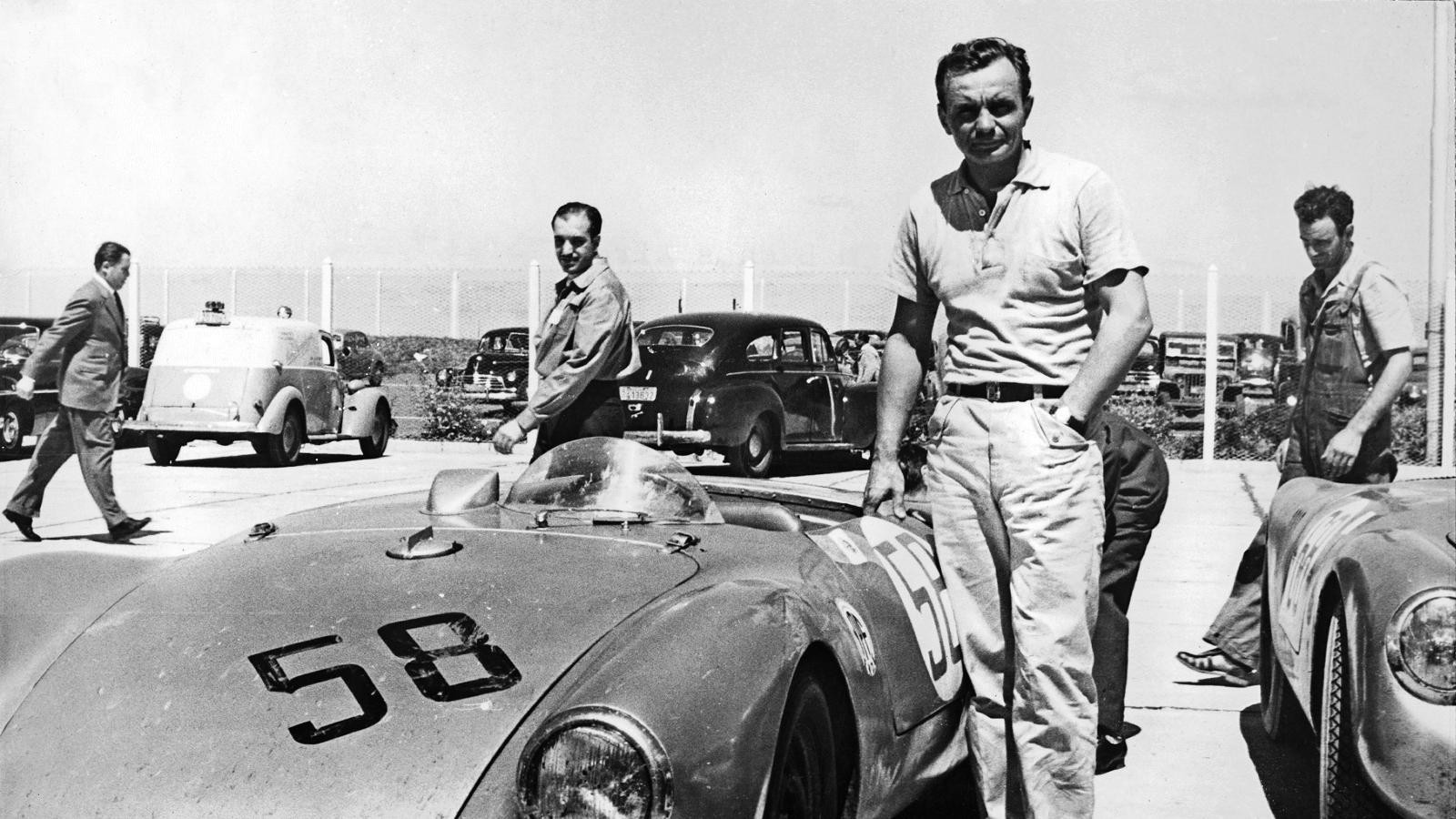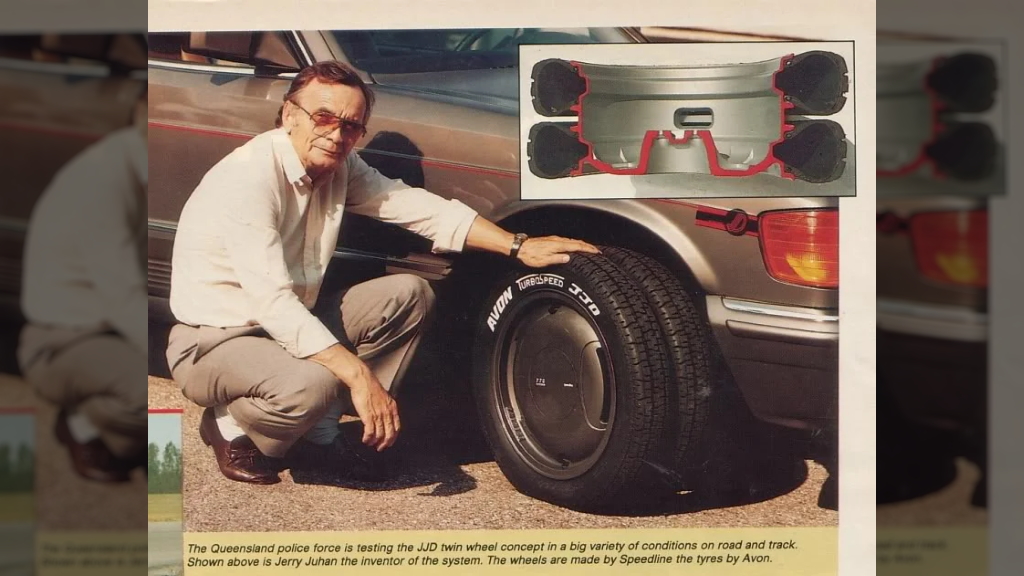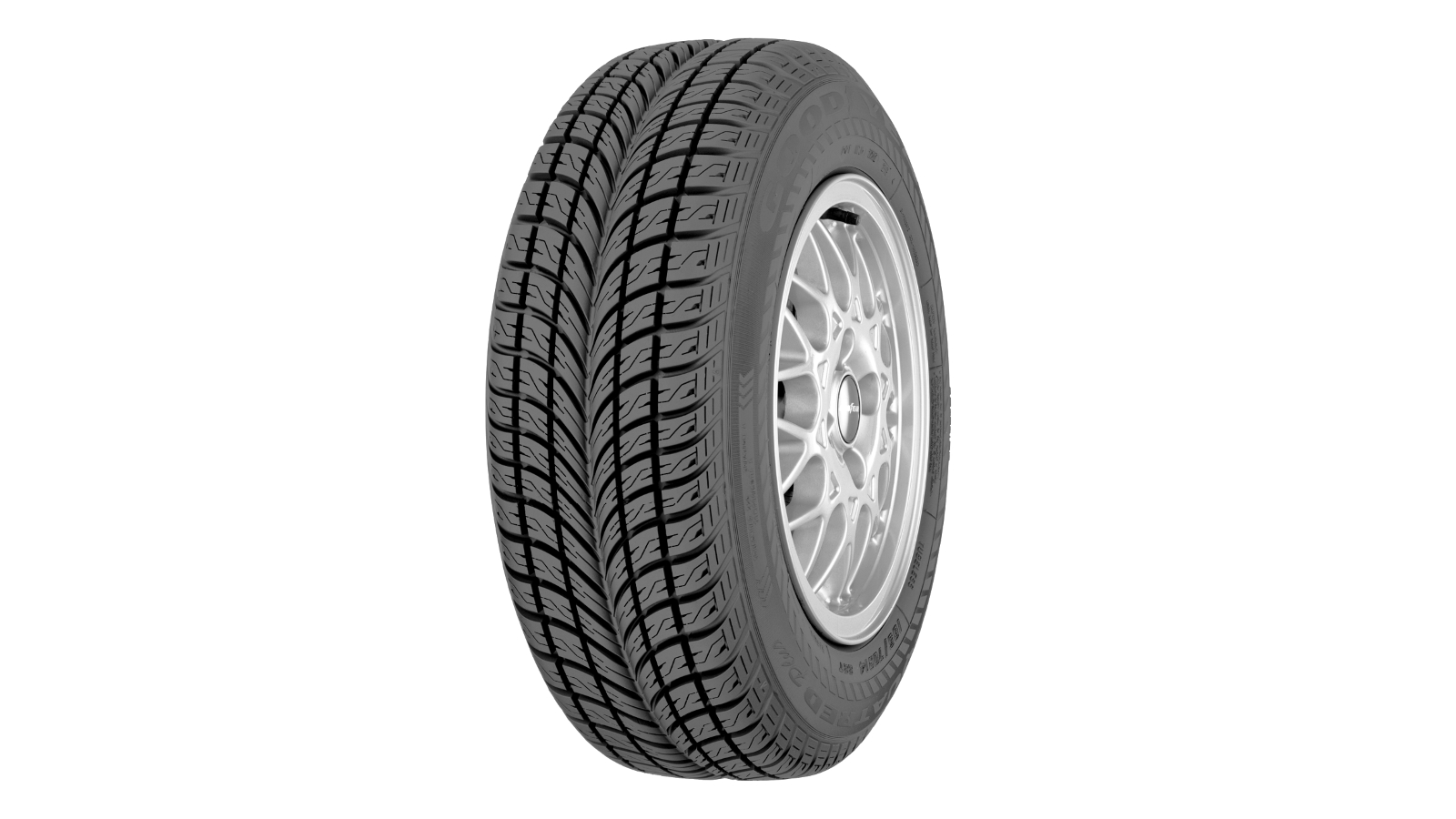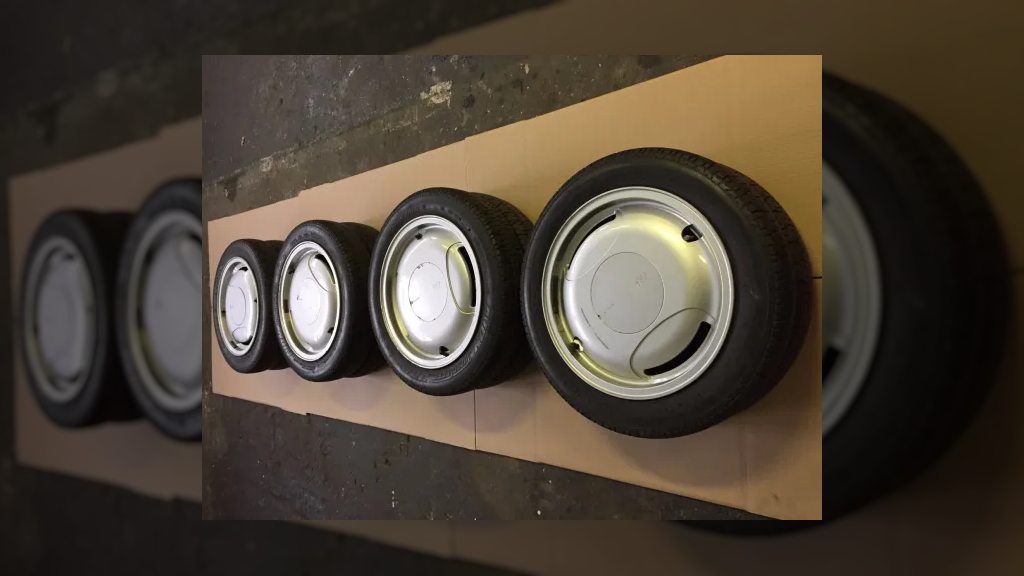Turning your car into a eight-wheeled monster by mounting two tires on each corner sounds like a violently American concept, up there with shooting a Baconator with an AR-15 and deep-frying a Chia Pet model of Billy Mays. So what if I told you that this bizarre arrangement was the brainchild of a Czech entrepreneur and racing driver who wanted the ultimate high-performance tire setup in all weather conditions? This is the story of JJD Twin Tyres and my god, is it ever interesting.

JJD Twin Tyres was the brainchild of one Jaroslav “Jerry” Juhan. Born in 1921, Juhan was a Czech gearhead with a fascinating life story. He started off importing Italian automobiles to Prague and was so successful at that venture, Fiat rang him up and asked if he wanted to assist with a project in Guatemala. According to Larry Crane of Road Scholars, Juhan packed his bags, arrived in Guatemala just before his 30th birthday, then promptly began laying down some roots in the local racing community. While Fiat’s operation in Guatemala fell apart, Juhan found success in other ventures.
After opening up a dealership offering imported European sports cars and establishing Guatemala’s motorsport governing body, Juhan added Porsche to his portfolio and drove a 356 1500 Super to victory in the Carrera de Pacifico. This gained Juhan great rapport with Porsche back in Stuttgart, leading to a moderately successful run in a series of Porsche 550s in the World Sportscar Championship and a drive at Le Mans. Finishing sixth, Juhan decided to compete at Le Mans again in a Ferrari 250 Testa Rossa, unfortunately failing to finish after his co-driver clipped Jay Chamberlain’s Lotus. The Ferrari was patched up and sent on to Vasek Polak in California, another Czech car dealer and racing driver with Porsche connections.

After Juhan’s adventures in Guatemala, he sensed growing political tension and crossed the Atlantic once more, settling down in Geneva in 1961. While in Europe, Juhan had an idea. What if two skinny tires on one wheel offered better wet traction than one conventional tire? Well, Juhan had some clout and was able to convince Avon and Speedline to make special tires and wheels respectively. All of a sudden, JJD Twin Tyres were born. Just like the case of the In-N-Out 8×8, JJD Twin Tyres worked on the principle of more is more.

Unfortunately, more tires also come with more downsides. Unsprung weight was apparently immense for the time. Moreover, special wheels were required to run Twin Tyres as two sets of beads were required. Beads? Oh yes, beads. Time for a quick tire and wheel tech tip” For a tire to sit on a wheel, there need to be mating flanges around the inner rim of the tire and the outer edge of the wheel, otherwise called beads. On the tire side, the bead is strategically reinforced so it can slip over the wheel with proper force and lubrication yet still keep the tire firmly on the wheel when the tire’s inflated. With Twin Tyres, two sets of beads were required per wheel which means twice the effort to mount tires as each tire needed to be inflated and seated separately. Check this out:
Now, there is a big positive to having two tires per corner. If one goes flat, who cares? Just keep driving. Imagine that — the major benefit of runflats without the rock-hard sidewalls. There’s another benefit that’s mostly for vehicles with aggressive alignments. If you ran a lot of negative camber on a car equipped with JJD Twin Tyres, you could flip the tires four times for increased inner edge life or just replace the inner tire when the tread wore shallow. Sure, this all sounds as labor-intensive as casting your own cylinder head, but so long as you own a tire machine you’d see brilliant savings.

More importantly, JJD Twin Tyres reportedly achieved its goal of brilliant wet weather performance. Australian V8 Supercars legend Colin Bond was quoted in an ad as saying, “I’ve never driven on anything so good in the wet.” This shouldn’t be terribly surprising when you consider JJD Twin Tyres’ design. Not only did each tire feature cross-tire water evacuation channels, the separation of the two tires created an enormous rain channel down the middle, a novel concept for the 1980s. To understand just what an advancement in rain channel tech the JJD Twin Tyres system was, let’s take a look at several premier tires of the 1980s, starting with the metric-sized Michelin TRX.

The TRX was kind of like the Pilot Sport 4S of its day, except with a couple of downsides. Not only did the TRX offer good rigidity and response, it was offered by everyone from Ford to Ferrari and utilized a bespoke bead design to provide a comfortable ride from what was once considered a low-profile tire. The TRX was also a huge pain in the ass because it used metric sizing but hey, not everything can be perfect. The common 220/55 VR 390 size used on Ford’s fox body cars, six-cylinder BMWs and eight-cylinder Ferraris ran on a 390 mm (15.35 inch) wheel that was much larger than the typical 14-inch sizing of the time. The trouble is, the tread design could have used some improvement. Sure, four circumferential grooves helped with rain evacuation, but shallow grooves can only do so much without logical water evacuation paths across the surface of the tread.

Goodyear noticed this and in 1982, released a tire called the VR50. Commonly known as the Gatorback, the VR50 was one of the first commercially-available directional tires and it was a massive step forward in rain performance. Why? Well, in addition to a handful of circumferential grooves, Goodyear carved swept rain channels from the center rib all the way out to the edges of the tread. This design did a remarkable job of evacuating water and went on to be copied by just about every major tire manufacturer under the sun. From all-weather tires like the Michelin CrossClimate+ to sticky summer gumballs like the Dunlop Direzza ZII Star Spec, directional tire design took the world by storm.
However, directional tires do have one notable shortcoming in everyday use. They can’t be rotated across the car. In an ideal situation, a square or non-staggered tire rotation without a full-size spare wheel would shuffle the front tires onto the back axle and the rear tires onto each opposing front corner. As suggested by the name, directional tires can only rotate in one direction. So what do you do? Well, you can either pair true cross-section channels that run the full width of the tire with circumferential grooves, or you could do what JJD did and mate cross-section channels from the center rib to the shoulder with two pairs of shoulders and circumferential grooves to create a tire with excellent water evacuation that’s able to be properly rotated.

So why aren’t JJD Twin Tyres more common and did they spawn any imitators? The answer to that second question is easy. Absolutely. In 1981, Goodyear engineers were asked to design a futuristic tire for a GM concept car. According to the Chicago Tribune, these engineers had heard about Jerry Juhan’s work in two-tire systems and knew about ongoing Eagle VR50 development at Goodyear. The engineers then bashed the concepts together and produced a directional tire that looked like two tires side-by-side. GM absolutely loved the tire, but Goodyear’s strange design was never considered for mass production. Speaking with the Chicago Tribune, Goodyear designer Sam Landers said, “Nobody scoffed at it, but it was not taken seriously as a commercial product.”
That all changed in the late 1980s. In 1989, Goodyear ran a series of focus groups and lobbed their concept car creation into the mix just to see what would happen. The weirdest thing happened – focus group members couldn’t take their hands off of it. Three years later in 1992, Goodyear rolled out the bizarre-looking Aquatred. It may have sounded like a men’s body wash and looked goofier than a groom showing up to his wedding wearing JNCOs, but it sold like Fall Out Boy merch at Warped Tour. Goodyear sold 300,000 of the damn things in their first three months on the market. It was such a success that Goodyear still uses the Aquatred name for their water-clearing design features decades after the original Aquatred tire exited production.

As for the failure of JJD Twin Tyres? It was a really niche solution that wasn’t marketed particularly well. See, JJD almost exclusively marketed its tire and wheel system through car magazine ads, not a great move when searching for a wide audience. In addition, the Twin Tyres setup was rather expensive due to requiring special wheels. According to the Los Angeles Times, a full setup ran between $1,200 and $2,500 in 1986 dollars. That works out to between $3,165.43 and $6,594.64 today, a massive chunk of money for a set of wheels and tires. Do you really think most car magazine readers had that sort of money to fork out on wheels and tires? Around the turn of the millennium, Juhan sold his company to an unspecified Indonesian conglomerate, which in turn folded a few years later. It may seem strange that one of the most interesting tire experiments in history isn’t even on its creator’s Wikipedia page, but if JJD Twin Tyres became commonplace, would they really be as interesting?







Aquatreds, in spite of their name, weren’t that good in the rain, except for two specific, if important instances. Stopping, and hydroplaning. They sucked at starting in the rain, and cornering in the rain. They were also top notch dry tires in their day.
It’s possible when they came out, they were the best in the rain, but after a few years, other brands cornered and started better in the rain, after a few sets of Aquatreds, I ending up switching to a Hankook model that was equal or better in every way, and cost less too.
Now I generally(hah!) use Altimaxes or Michelins, depending on what’s available for the car in question.
I just remember the Aquatread commercials seemed to run non-stop there for a while.
On topic: it wouldn’t solve the weight issue, but wouldn’t it be simpler to make two skinny wheel and tire sets that mount like dualies?
I remember reading about these in Popular Science. I also remember how racy and meaty those VR50s looked on the new for ’84 Corvette.
An American company tried to revive this concept in the 90s. I got to be a factory tester because they were a local company. Didn’t go well because the wheels were designed wrong and didn’t fit my car. They folded soon after.
I sold a few sets of these new when I worked at Tire Rack starting in the mid-80’s, and a few sets of replacement tires for them as well. But it was replacing TRX tires and wheels with aftermarket alloys and conventional tires that paid my rent and bought me a 911. Thanks BMW and Ford!
And yes, I sold Ronal Teddy Bears, and Daisy wheels too. There’s no accounting for some people’s tastes.
_According to the Los Angeles Times, a full setup ran between $1,200 and $2,500 in 1986 dollars._
And you could buy a V8 Mustang for under $8000.
That tire money also be about what a good286 would cost. A top end 386? that was Mustang money
I remember the twin tires and actually saw a set at either a dealer or the NY Auto Show. It was an interesting idea, but cost more than my old Scirocco. BTW the Scirocco ran Michelin MXL tires, one of the first asymmetric tread designs
I seem to recall these are one of the earliest examples i remember of seeing something debunked.It was an interesting experience because i believed the hype at the time.
Clearly they were better in standing water but how much compromise (cost,weight) can you cope with to achieve that?
I recall my father putting a set of Aquatreds on the family 1991 Dodge Grand Caravan (maroon with DI-NOC ‘paneling’). A die-hard Michelin man, it took some serious marketing bullshit to pull him off that track. I’m pretty sure he put that van in a set of MX4s before it was all said and done. Probably replaced a transmission each time he replaced a set of tires.
I recall reading that one major problem these tires had was a very stiff ride due to having twice as many sidewalls.
Thanks for the great trivia!
But, you missed a great chance to show that commercial where they ran an Aquatread over a puddle on glass(?) and filmed it from below.
I never had a set: a set cost about twice what I paid for cars back then
Hey yeah, I remember seeing ads for these in Car & Driver way back when. Aquatreads too, but of course those were way more mainstream. I wonder if there are still any tires and rims knocking around somewhere.
Holy crap. I had forgotten all about Twin Tires. I remember those ads in magazines back in the day.
I always wondered why Michelin made a “metric” tire with a 390mm wheel? Why wouldn’t you go 400mm?
I had a set on my 83 Mustang and they were a total PITA to replace since you had to go to Michelin and if they were out of stock, you were SOL – which happened to me when I got had a tire with a sidewall gash once, no TRX tires in my size were available for 6 weeks so I had to run on the mini spare for the entire time.
I had a set of Aquatread Eagles on my Plymouth Sundance America. Tires cost nearly 10% of what the car cost new. They were great.
You could have gotten Goodyear Wingfoots. Their whole reason for being was that the TRX was expensive.
Sometime in 1992-1993, I put a set of Aquatreds on my ’91 Mitsubishi Precis. (Don’t remember that model? It was a Hyundai Excel hatchback with a Mitsu badge.) I don’t recall what OEM tires they replaced, but at the college dorm parking lot I got a TON of compliments on how they looked, and my memory is that they sure seemed to improve the ride and handling.
Not as much improvement as I got with the Pilot Sport PS2’s over the OEM Pilot Sports on my e46 a decade later, but Aquatreds were definitely memorable.
Oh wow, they badge-engineered a Hyundai Pony! Wasn’t it universally hated back then? That’s some crazy-ass business model, get the shittiest car possible and slap your brand’s badges on it.
Actually I had friends who loved their Pony. They replaced it with the very first year Excel, and that was the end of their Hyundai enthusiasm.
I like the way they routed the inside tire’s valve stem.
Great article. I’m really loving the mix of content with historical features, wrenching, road trips, new car reviews, car design, and engineering dives. I’m sure you guys are going to keep growing, but if you guys throw in some content about market trends and amateur racing (ala grassrootsmotorsports) I’d be in heavens. Those are just my personal preferences though, I’m really enjoying the site as is.
Too bad they don’t make the Aquatred anymore 🙁
I’m surprised someone else hasn’t copied it yet!
I never rode in a car with them, but I wonder how noisy they are? It seems like tires with aggressive V cuts like that are really loud at speed.